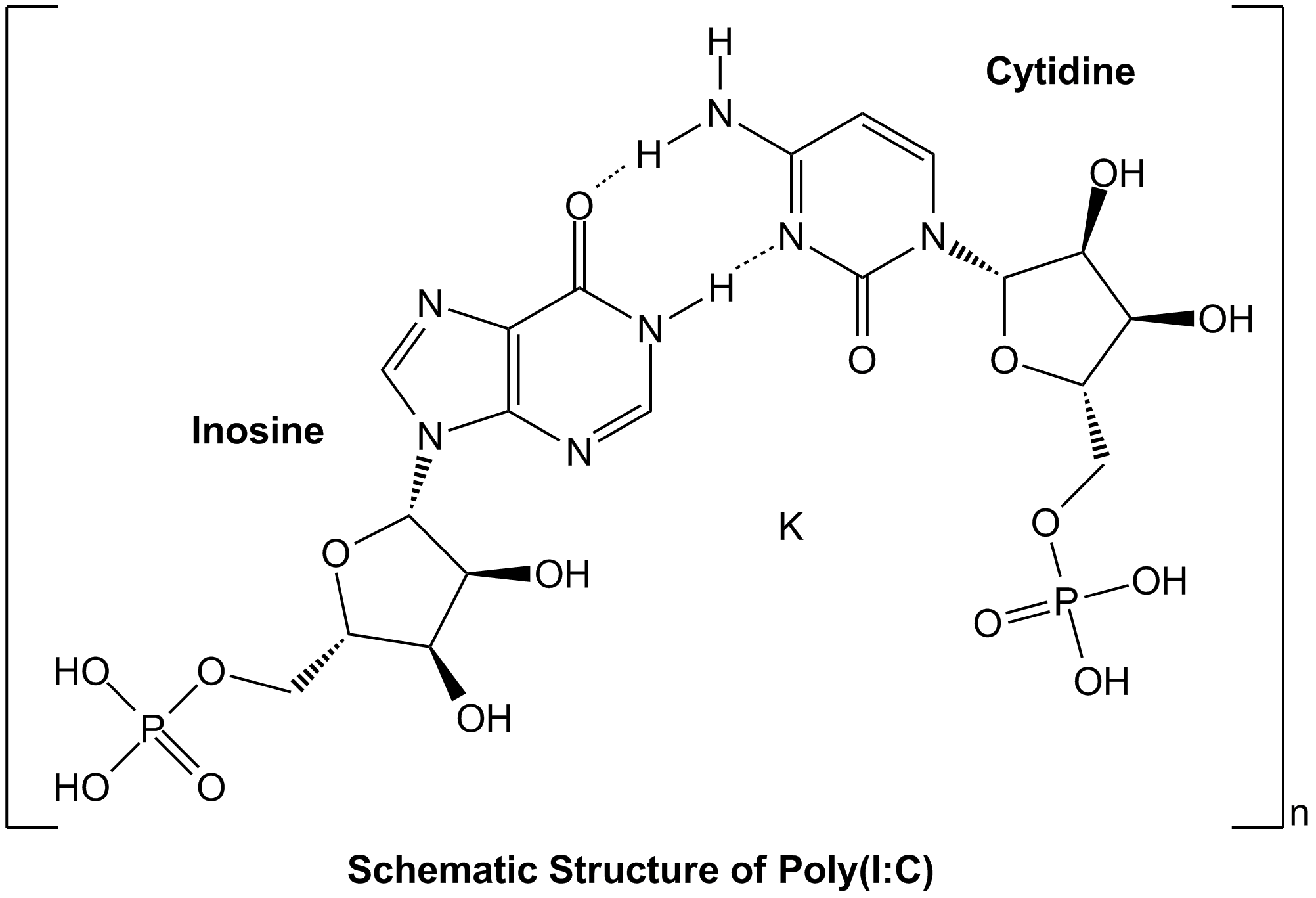Polyinosinic-polycytidylic acid [Poly(I:C)] Endotoxin-free (sterile)
Product Code:
IAX-200-021
IAX-200-021
Regulatory Status:
RUO
RUO
Shipping:
Ambient
Ambient
Storage:
+4°C
+4°C
No additional charges, what you see is what you pay! *
| Code | Size | Price |
|---|
| IAX-200-021-M002 | 2 mg | £124.00 |
Quantity:
| IAX-200-021-M005 | 5 mg | £168.00 |
Quantity:
| IAX-200-021-3005 | 3 x 5 mg | £460.00 |
Quantity:
Prices exclude any Taxes / VAT
Stay in control of your spending. These prices have no additional charges to UK mainland customers, not even shipping!
* Rare exceptions are clearly labelled (only 0.14% of items!).
* Rare exceptions are clearly labelled (only 0.14% of items!).
Multibuy discounts available! Contact us to find what you can save.
This product comes from: Switzerland.
Typical lead time: 7-10 working days.
Contact us for more accurate information.
Typical lead time: 7-10 working days.
Contact us for more accurate information.
- Further Information
- Documents
- References
- Related Products
- Show All
Further Information
Alternate Names/Synonyms:
Polyinosinic-polycytidylic acid, potassium salt (poly (I:C))
Biological Activity:
Activates TLR3, MDA5/Helicard and RIG-I. Optimal working concentration depends upon target receptor accessibility, number, density, as well as cell type, and therefore needs to be determined for each application. Recommended concentration range: in vitro: 0.5-10µg/ml; in vivo: 5mg/kg.
CAS:
31852-29-6
EClass:
32160000
Endotoxin:
<0.002EU/µg
Form (Short):
liquid
Formulation:
Lyophilized. Sterile.
Handling Advice:
Avoid freeze/thaw cycles.After reconstitution, prepare aliquots and keep aqueous stock solutions for 1 day at 4°C or store at -20°C (shelf-life 6 months).
Long Description:
Chemical. CAS: 31852-29-6. MW: High molecular weight (>1.5kb). Toll-like receptor (TLR) 3 is an endosomal TLR that mediates immune responses against viral infections upon activation by its ligand double-stranded RNA, a replication intermediate of most viruses. TLR3 is expressed widely in the body and activates both the innate and adaptive immune systems. Toll-like receptor 3 (TLR3), melanoma differentiation-associated gene 5 (MDA5), and retinoic acid-inducible gene-I (RIG-I), all sensors of double-stranded RNA (dsRNA) are potent inducers of antiviral activity. dsRNA sensor activation -e.g. by poly (I:C)- induces pro-inflammatory TNF-alpha and antiviral IFN-beta, but can also enhance the expression of pro-apoptotic proteins. Recently, poly (I:C)-induced cell death recently gained considerable attention as a tool to study the 'Ripoptosome' or 'Necrosome' complex, a novel intracellular signaling complex, thought to induce regulated necrosis, also called 'Necroptosis'.
MDL:
MFCD00131983
Molecular Weight:
High molecular weight (>1.5kb).
Other data:
Contains: 2mg and 5mg sizes include 1.5ml ddWater Endotoxin-free (sterile) (Cat. No.: IAX-900-002-LD15). 10mg size includes 10ml ddWater Endotoxin-free (sterile) (Cat. No.: IAX-900-002-L010). Reconstitution Note: For optimal dissolving, add 50% of solvent and let dissolve for 10min. Add remaining 50% of the solvent and mix thoroughly. Moderate warming may aid dissolving.
Package Type:
Plastic Vial
Product Description:
Toll-like receptor (TLR) 3 is an endosomal TLR that mediates immune responses against viral infections upon activation by its ligand double-stranded RNA, a replication intermediate of most viruses. TLR3 is expressed widely in the body and activates both the innate and adaptive immune systems. Toll-like receptor 3 (TLR3), melanoma differentiation-associated gene 5 (MDA5), and retinoic acid-inducible gene-I (RIG-I), all sensors of double-stranded RNA (dsRNA) are potent inducers of antiviral activity. dsRNA sensor activation -e.g. by poly (I:C)- induces pro-inflammatory TNF-alpha and antiviral IFN-beta, but can also enhance the expression of pro-apoptotic proteins. Recently, poly (I:C)-induced cell death recently gained considerable attention as a tool to study the 'Ripoptosome' or 'Necrosome' complex, a novel intracellular signaling complex, thought to induce regulated necrosis, also called 'Necroptosis'.
Purity:
>99%
Transportation:
Non-hazardous
UNSPSC Category:
Nucleotides
UNSPSC Number:
41106305
Use & Stability:
Stable for at least 2 years after receipt when stored at +4°C.
Documents
References
The 'complexities' of life and death: Death receptor signalling platforms: L.S. Dickens, et al. Exp. Cell Res. 18, 1269 (2012) | Inhibitor of apoptosis proteins limit RIP3 kinase-dependent interleukin-1 activation: J.E. Vince, et al. Immunity 36, 215 (2012) | 'Necrosome'-induced inflammation: must cells die for it? D. Wallach, et al.; Trends Immunol. 32, 505 (2011) | Pick your poison: the Ripoptosome, a cell death platform regulating apoptosis and necroptosis: M. Feoktistova, et al.; Cell Cycle 11, 460 (2012) | Ripoptosome: a novel IAP-regulated cell death-signalling platform: G. Imre, et al.; Mol. Cell Biol. 3, 324 (2011) | IAPs: guardians of RIPK1: M. Darding & P. Meier; Cell Death Differ. 19, 58 (2012) | The Ripoptosome: death decision in the cytosol: M.J. Bertrand & P. Vandenabeele; Mol. Cell 43, 323 (2011) | cIAPs block Ripoptosome formation, a RIP1/caspase-8 containing intracellular cell death complex differentially regulated by cFLIP isoforms: M. Feoktistova, et al.; Mol. Cell 43, 449 (2011) | The Ripoptosome, a signaling platform that assembles in response to genotoxic stress and loss of IAPs: T. Tenev, et al.; Mol. Cell 43, 432 (2011) | Proapoptotic signalling through Toll-like receptor-3 involves TRIF-dependent activation of caspase-8 and is under the control of inhibitor of apoptosis proteins in melanoma cells: A. Weber, et al.; Cell Death Differ. 17, 942 (2010) | TLR3/TICAM-1 signaling in tumor cell RIP3-dependent necroptosis: T. Seya, et al.; Oncoimmunology 1, 917 (2012) | JAK/STAT signaling pathway in Artemia franciscana: R.J.P. Pascual; Faculty of Bioscience Engineering, University of Gent (2019) | Inhibition of PI3Kdelta Enhances Poly I:C-Induced Antiviral Responses and Inhibits Replication of Human Metapneumovirus in Murine Lungs and Human Bronchial Epithelial Cells: A. Fujita, et al.; Front. Immunol. 11, 432 (2020)
Related Products
| Product Name | Product Code | Supplier | |||||||||||||||||||||||||||||||||||||||||||||||||||||||||||||||||||||||||||||||||||||||||||||||||
|---|---|---|---|---|---|---|---|---|---|---|---|---|---|---|---|---|---|---|---|---|---|---|---|---|---|---|---|---|---|---|---|---|---|---|---|---|---|---|---|---|---|---|---|---|---|---|---|---|---|---|---|---|---|---|---|---|---|---|---|---|---|---|---|---|---|---|---|---|---|---|---|---|---|---|---|---|---|---|---|---|---|---|---|---|---|---|---|---|---|---|---|---|---|---|---|---|---|---|---|
| Trehalose 6,6-dimycolate (TDM) [Cord Factor] Endotoxin-free (sterile) | IAX-200-101 | Innaxon | Summary Details | ||||||||||||||||||||||||||||||||||||||||||||||||||||||||||||||||||||||||||||||||||||||||||||||||



